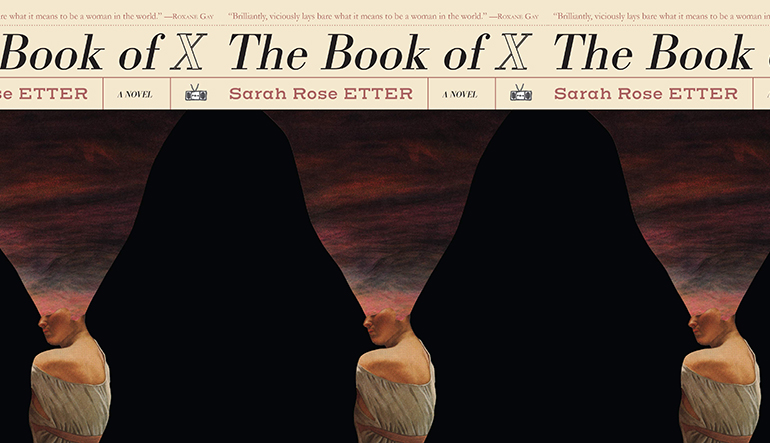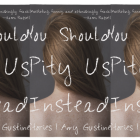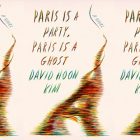“I no longer think the driving force of books is to tell everyone that everything will get better”: An Interview with Sarah Rose Etter

Sarah Rose Etter’s recently published debut novel, The Book of X, tells the story of Cassie, who comes of age in a world similar to our own, though one with a few surprising departures. In Cassie’s world, meat grows in the ground and must be harvested—a man’s job and her father’s profession. Most notable, however, is Cassie’s knot. Like her mother and grandmother before her, Cassie is born with a knotted abdomen. “Picture three women with their torsos twisted like thick pieces of rope with a single hitch in the center,” she instructs. Her own knot “is strained and stretch-marked, shining and hard.” It’s an aberration that flummoxes the medical community but one they ultimately let drop.
There are, however, aspects of Cassie’s world that feel very familiar. Her mother is obsessed with women’s magazines and constantly foists their advice on Cassie. She tells Cassie to diet by sucking on rocks, that she must do something with her face, that yellow is the color of season—a litany of self-improvement suggestions that can never “fix” what truly prevents the women from meeting conventional beauty standards: their knotted abdomens. Cassie is also ruthlessly teased on the playground. She has a best friend she idolizes who calls her knot ugly but befriends her anyway. She has a first crush whose attention to her is disastrous.
While Etter’s novel is a clear portrayal of what it means to be a woman, other themes are important, too—family in particular. Cassie is bound to the women of her family through her knot, but she is equally yoked to her family, which provides her with some semblance of a safe space. Despite her mother’s harshness, her father’s alcoholism, and her older brother’s mundane cruelties, she emotionally clings tightly to them even as she draws physically away. Her father’s death destroys her.
In the end, it isn’t beauty and self-loathing that drives Cassie to have her knot removed, but physical necessity. She experiences pain so intense she blacks out, and when she consults a doctor about the pain, he tells her that the knot is likely squeezing her vital organs and that she is a candidate for emergency surgery to get her “back to normal.” Of course, the irony here is that it’s the knot that’s normal for Cassie and anything else would be a blessed respite from the pain it causes her. Although Cassie has the knot removed for health reasons, there’s also the implication that she can now be normal and therefore beautiful. As soon as she recovers, though, it’s clear that being knotless isn’t the solution to her troubles she’d dreamed of as a little girl. Her co-worker comments that she’s been “fixed up”; a man on the street calls her an “ugly bitch.” Another man she hooks up with leaves because of what he terms the “fucked up marks” on her stomach. Cassie thinks, “My body is slack now, knotless.” Her surgery separates her from her legacy without reciprocating with something greater.
Etter, who wrote much of the novel while in Iceland, joins a legacy of women writers who depict the horror of women’s experiences. I recently spoke with her about what it was like to tell Cassie’s story and how this novel functions both in the story it tells and the history it is situated in.
Sarah Appleton Pine: Your book is structurally interesting right from the beginning. There are bits of narrative spliced with bulleted facts as well as with Cassie’s visions, which are clearly based on what’s going on in her life. How did you arrive at this narrative structure?
Sarah Rose Etter: As bold and ridiculous as this sounds, I did want to write a novel as it had never been written before. When I think about the American novel, we have so many great books that have already mastered the traditional narrative arc. I wanted to create a book that was structurally new. So I started with a spreadsheet, which I used to map some short stories I had written to each other. I was looking for overlapping themes, and for ways in which those stories might speak to each other. I loved the idea of having a character that had a life interspersed with daydreams that spoke to her reality. So Cassie’s narrative was mainly written in Iceland, but I always knew these visions would be worked in throughout the book.
That part took so much editing—to put the right visions in the right place, to make sure the facts lined up with her life, a lot of moving pieces and bits around. Part of the structure also came from a desire to give the reader some breathing room—since Cassie’s life is so difficult and hard, splicing in the lists of facts helped ensure the reader wasn’t totally overwhelmed by the grotesque.
SAP: The world of the novel is largely similar to ours, and I’m curious about the choices you’ve made that separate our world from the novel’s. For example, the knot feels both literal and figurative—it’s an expression we use. Still, that her abdomen is literally knotted is surprising and vivid. Equally surprising to me is the Meat Quarry and the blood pooling in the earth. Did these choices feel obvious to you or was there some experimentation to arrive at these departures?
SRE: I was writing the book in a pretty rural part of Iceland. I was there for about thirty days, by myself in a cabin. There’s a book called From Where You Dream by Robert Olen Butler that recommends waking up every day and going to your desk to write—no coffee, no brushing your teeth, nothing. It’s sort of a way to keep your dream state before you go into the drafting. For this book, that gave me room to experiment—I wanted to create a world that was suspended in time and space, but still dealt with issues like the female body, capitalism, life, love, death. For Cassie’s knot, it just came to me in the first line—I was thinking a lot about heredity, and about what is passed down to us from our mothers. I wanted to tunnel into discussing the body in a way that wasn’t limited to just one thing. The knot can be a stand-in for so much—depression, anxiety, weight issues, the list goes on. I hoped that would make it more relatable.
It’s so funny—so many people ask about the Meat Quarry, but I was really just trying to invent a way to talk about capitalism and industry and rural areas without placing them directly in America or in a place or time. I also wanted to get at issues of blood and body in a way that was as surreal as Cassie’s body.
SAP: Cassie’s life is colored early on by her relationship with the opposite gender, and her experiences are typically negative or even traumatic. Only at the end does she experience a positive (romantic) relationship. Although her father is an alcoholic and we don’t see many positive interactions between her, her mother, and her father, Cassie and her mother mourn her father extremely, and his death so devastates Cassie that she never recovers. Why is it her father’s death that so derails Cassie?
SRE: Despite her father’s alcoholism, he is really one of her only safe harbors from the rest of the world. He almost never speaks of her body, and he allows her to try to work in the Meat Quarry. Their phone calls, too, are stabilizing for her. They joke with each other, they go to cemeteries together, there is a deep love there. I’d argue he’s one of the only positive figures in her entire life that is a man.
With this book, I did also want to explore what happens to someone who has no working models for healthy relationships, who experiences trauma, and who has to operate in the aftermath of that. Cassie struggles to express her love for her family, but that doesn’t mean it isn’t there and that it isn’t a large part of her. The complicated nature of having a family that isn’t perfect doesn’t cut off the idea that she loves them.
SAP: Cassie’s story is both heartbreaking and relatable, even though it’s set in a world with clear departures from our own. How challenging or organic or painful was it to craft Cassie’s story?
SRE: I did lose my mind while writing this book. Anyone close to me saw how hard it was—truly, this book is fiction, nonfiction, and memoir put into a blender. You could open certain pages and find me in there, and other pages I am not there at all. It was harrowing to write. There were many times throughout the writing, editing, and publishing process where I felt flipped inside out. I went through periods of time where I didn’t want to be seen by anyone because I felt so vulnerable for writing this book. I was frequently crying in public. I felt completely undone by this book in many ways. And I still struggle with all of this on book tour. It’s a hard book to stand next to in some ways. I affectionately refer to this book as my tumor, but it’s true. It’s beautiful and grotesque and ugly and visceral and bloody and full of teeth and hair and bits and pieces, and I am in there somewhere, too.
SAP: The Book of X captures essential parts of a woman’s bildungsroman: a longed for, beautiful best friend; a difficult mother clearly wrestling with her own insecurities; something forbidden, particularly because of gender; etc. Did you initially conceive of The Book of X as a bildungsroman? Are there other themes in the novel that are more essential to you?
SRE: It’s interesting because I never set out to write a feminist novel, or a bildungsroman, or a coming-of-age story. I just heard that first line humming in my head, and I followed it into the world it needed to exist in. I am a big fan of the Donald Barthelme essay on not knowing—not setting out to write any particular novel at all, I did have a three-part structure in my head that was important to me, so I did have a loose idea of wanting three arcs for her life. I knew I wanted to capture the entire scope of her existence as best I could. Genuinely, I just sat down to write about a woman born in the shape of a knot, and I fell into the rabbit hole. I got to exist in her world and write it all the way through. It’s a place I don’t think I could ever get back to or re-open in myself. I have a friend who tells me frequently that when you write a novel, a portal opens up in your brain and it only stays open for as long as it takes to write the book. That feels true for this book—it came out through me, but I wasn’t really controlling it until the editing process. So much of it came about organically.
SAP: Just as the bulleted facts interspersed in the narrative work to connect Cassie’s story to history, your novel clearly fits into a greater literary history to me. How do you see your novel fitting into history? What do you make of the timing of its publication in our current climate?
SRE: I very much feel like I no longer have control over this book and where it goes. I wrote it, and now it goes out into the world on its own two legs. It’s sort of like having a child and then having to release control. So many writers throughout time have written books and hoped those books would land somewhere in history—I have no idea, maybe this book will matter right now, maybe in ten years no one will think of it ever again. I do know it felt more important to publish this book after Trump was elected. It felt incredibly necessary as a response to what we’re living in now. And I think we’re seeing a shift in the American novel as a direct response to how terrible the world feels right now. We’re seeing more work where characters deal with trauma, where narratives are unresolved, where the plot isn’t tied up in a pretty pink bow. I no longer think the driving force of books is to tell everyone that everything will get better. Life is messy, therefore it is an accurate reflection of life and society if books are messy, too. I hope this book lands in a way that it paves the way for other young writers, especially marginalized writers, to experiment, innovate, and tell their truths in fiction.



